Luxury Travel Review

Spa indulgence in Nevis
Article and photos by Elena del Valle
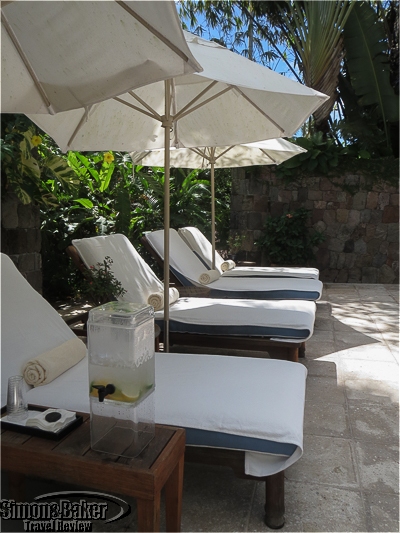
One of several outdoor areas at the Four Seasons Spa
Heading to the tiny island of Nevis in the West Indies I was unsure what to expect in the way of spas. I was pleased to discover several options. I tried three facilities, the spa at the island’s largest and best known resort, a family run spa and salon in a residential area, and a small salon in the main town of Charlestown, both locally owned.
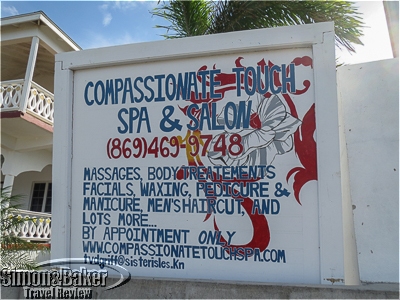
The Compassionate Touch Spa and Salon was in a residential area
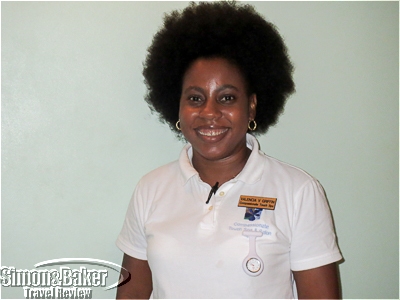
Valencia Griffin, co-owner and therapist, Compassionate Touch Spa and Salon
The spotlessly clean 1,848 square foot Compassionate Touch Spa (Nisbet Estate, Saint James Parish, Nevis, +1 869 469 9748, +1 718 594 1712,wwwcompassionatetouchspa.com, tdgriff@sisterisles.kn) in a tranquil village on the north side of the island could accommodate up to five guests at a time. Because we arrived late my Nevis Therapeutic Massage was cut short, although there was time for an owner led walk through the facility before my treatment. Established in 2001, the spa had been renovated in 2007. In addition to owners David and Valencia Griffin there were three staff. Ms. Griffin trained at the Nothern Institute of Massage of the Essex School of Beauty. There was a wet treatment room, a pedicure room, three massage or facial rooms, one manicure room and a waiting area. There were lockers, robes and slippers.

Tip Toes Nail Salon was in the main town of Nevis
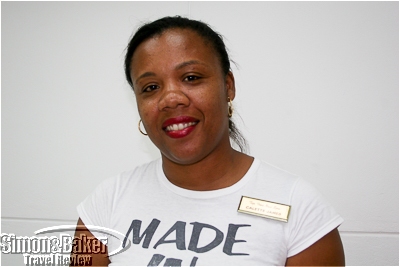
Calette James, owner, Tip Toes Nail Salon
I stopped in Charlestown for a massage by Calette James at the Tip Toes Nail Spa and Beauty Haven (Hunkins Plaza, Charlestown, Nevis, +869 762 4500, tiptoesnailsspa869@gmail.com), a facility near the main road. It had a reception area and a treatment room. Guests had access to a locked and clean shared restroom behind the salon.

My smoothie and a bento box with fresh fish at The Spa at Four Seasons Resort Nevis tasted as good as it looked
The Spa at Four Seasons Resort Nevis (P.O. Box 565, Pinney’s Beach, Charlestown, +869 469-1111, http://www.fourseasons.com/nevis/spa/spa_overview/, spaConcierge.nev@fourseasons.com) was located within the resort, which in turn was on Pinney’s Beach. Open to hotel guests and the public the spa was popular, though not crowded, while I was there in the low season. A staff of 23 worked at the 12,000 square foot establishment with 12 treatment rooms, six outdoor freestanding cottages and six indoor treatment rooms.
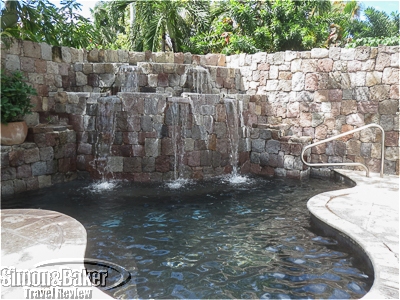
The heated jacuzzi at The Four Seasons Spa was popular
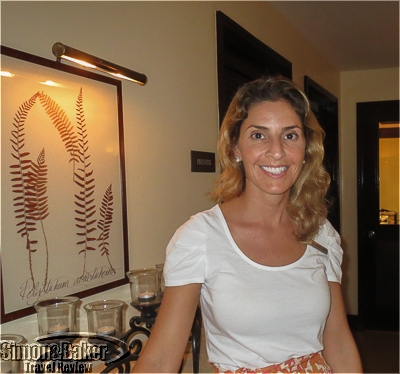
The manager at the Four Seasons Spa
During several hours of spa indulgence I spent time in the outdoor volcanic stone whirlpool bath, cold plunge sala style pool with viewing deck of Nevis Peak (Mount Nevis) and a golf course, had a Spa Cuisine Bento Box Lunch made fresh at the resort, and received a Nevisian Massage (no longer available) in an outdoor cottage. The spa manager, Bernadette Gonnet, was in the reception area when I arrived and made several helpful suggestions. The staff members I met were friendly and the facilities quiet and pleasant. It was one of the highlights of my Nevis trip.
Bloomington trail offered pedestrians, cyclists space, greenery amid central urban setting
Article and photos by Elena del Valle
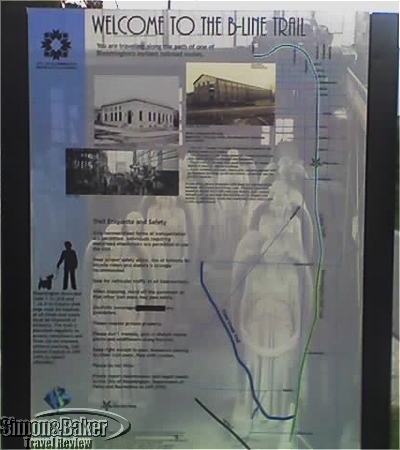
Signs along the trail described its history
During a recent stay in Bloomington, Indiana I discovered the B-Line Trail, a 12 food wide asphalt, multi-use 3.1 mile pedestrian and cyclist pathway, when I asked about jogging near my centrally located hotel. Meetings and activities kept me busy the majority of the days and into the early evenings. Taking advantage of the little free time I had at my disposal in the early mornings I set out to explore as much of the trail as I could.
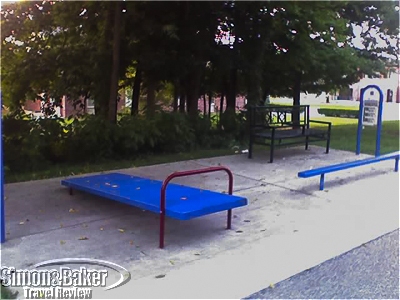
One of five different exercise devices in three fitness stations on the trail, south of First street
It ran from the east side of Adams Street, through downtown, past the switchyard property, to the north side of Country Club Drive. It had well marked ground level street crossings at the intersections. Many of the cars stopped or slowed down when they saw pedestrians at the crosswalks. There were pedestrian bridges over Third Street and Grimes Lane. There were paved plaza areas next to City Hall, at the WonderLab Museum, behind the Convention Center, and at Seminary Square shopping center. There were exercise stations, benches and public art scattered along the trail, especially near the downtown section.
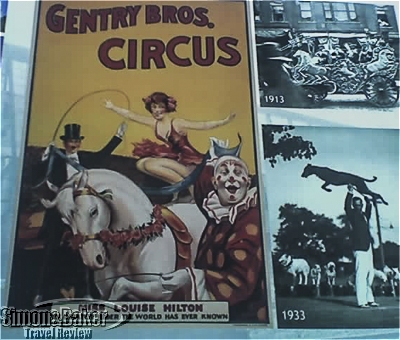
There were signs highlighting spots along the trail
Perhaps because of the summer break it was a bit lonely jogging in the predawn hours. Some of the graffiti peppered under bridges and abandoned buildings spooked me at first. As the sun rose, there were more people cycling, walking, jogging and walking their dogs. Some took advantage of the two foot wide gravel shoulders on each side.
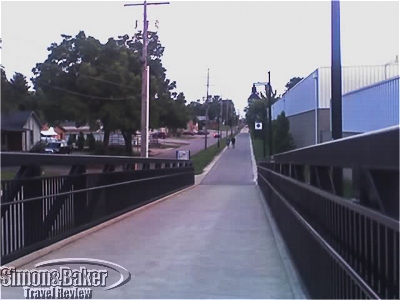
A view down the trail in the early morning from one of the bridges
Every so often there were garbage bins, bags for dog poop, and new looking LED street lamps on the trail. Even in the area furthest from downtown Bloomington it was never dark for very far on the path. Along the green sections, bird song mixed with the background buzz of early morning traffic and the mechanical sounds of nearby construction. Every once in a while I spotted birds. One mornings, I saw a rabbit next to the trail.
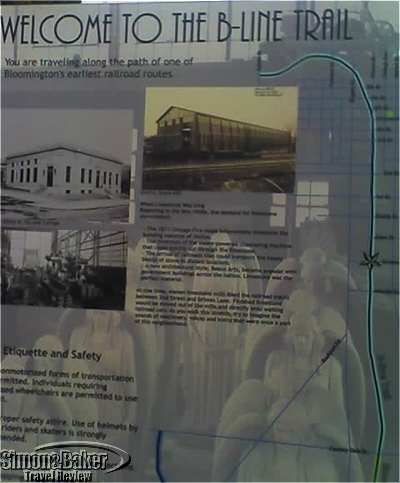
One of many signs that marked the trail path
Signs described the project, which was accomplished by the city through land acquisition for the three-mile former rail corridor (most of the costs, 80 percent, were funded by federal grant dollars). Other signs highlighted historical landmarks and public art. There were eight art pieces on the trail. I noticed a weathered steel sculpture titled “Dancing Spirit” near downtown. Some of the buildings I passed had murals made possible by a city grant.
The city had bought 28 acres of land adjacent to the southernmost section of 1.25 miles from Grimes to Countryclub in the abandoned former McDoel Railroad Switchyard. Administrators planned an addition to be named Switchyard Park and meant to feature outdoor performing arts venues, active recreational sport courts, walking trails, skatepark, splash pad, playground, and large multi-use facility.
Every morning I looked forward to my walks and jogs on the trail. They allowed me to exercise and discover a little of the city and its history, including some brush and greenery. On the path, I came across a convenient grocery store and a small cafe where I bought nutritious and tasty smoothies. The next time I visit Bloomington, I will seek accommodations near the B-line Trail. Perhaps by then the Swityard Park project will be complete.
A tiny slice of Tibet in Bloomington, Indiana
Article and photos by Elena del Valle
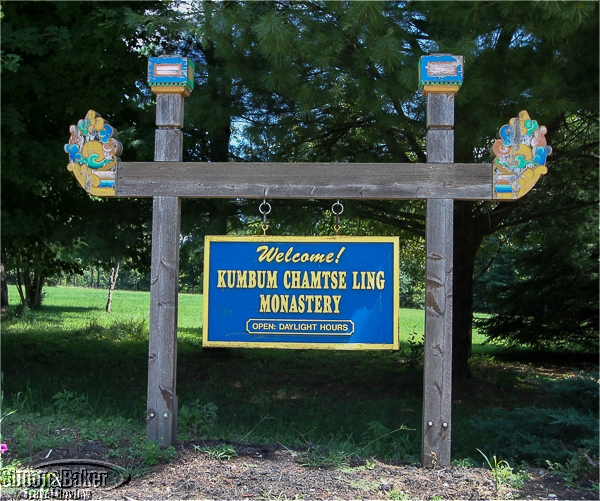
One of two signs at the entrance to the Kumbum Chantse Ling Monastery in Bloomington, Indiana
My favorite attraction during a three-day visit to Bloomington, Indiana was the Tibetan Mongolian Buddhist Cultural Center (TMBCC). As soon as we arrived at the brightly painted Tibetan style entrance gate I was transported back to Asia. A scant five miles from the city center the 108-acre property housed Chamtse Ling Temple, Cultural Building, two traditional Tibetan stupas, four retreat cottages, a Teaching Pavilion and two private residences. In the Cultural Building, where I and my tour group spent most of our time, there was a library, a kitchen, community space and an amply stocked gift shop.
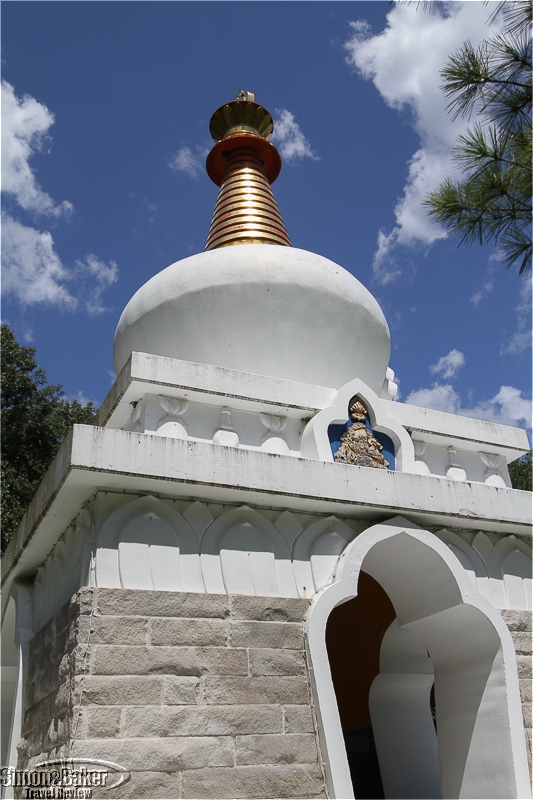
The stupa at the Tibetan Mongolian Buddhist Cultural Center
Founded in 1979, the Center’s three main goals were to foster and preserve Tibetan and Mongolian cultures, provide Buddhist teachings to the community, and promote interfaith peace and harmony. As a monastery it had a permanent small monk population that lived onsite year round. The center and temple were open to the public.
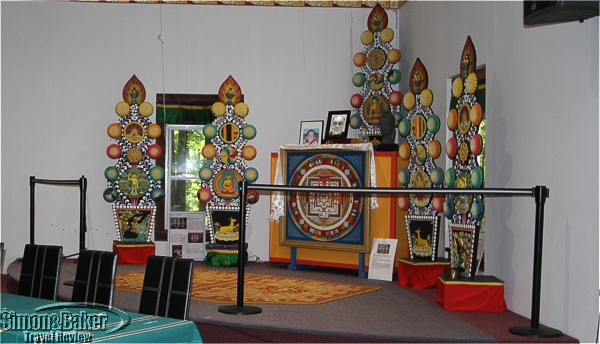
A meeting room at the Tibetan Mongolian Buddhist Cultural Center
We began by visiting the Cultural Building’s Main Hall, where we had lunch in an informal area adjoining the kitchen. Following the simple self serve meal of delicious noodle soup, corn on the cob, and lettuce with a memorable dressing (although there was hardly any lettuce by the time I had a chance to serve myself, the dressing was my favorite part), we moved to an adjacent meeting room.
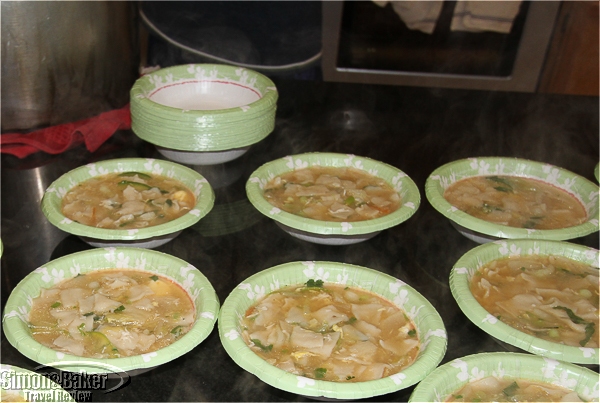
We had self serve noodle soup, corn on the cob, and lettuce salad for lunch
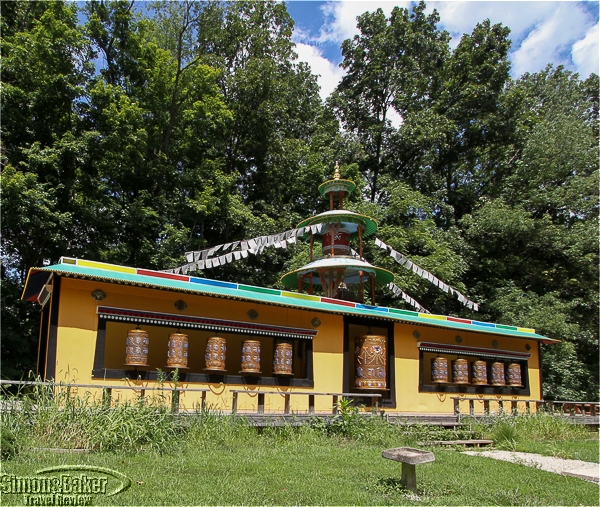
Wheels at the Tibetan Mongolian Buddhist Cultural Center
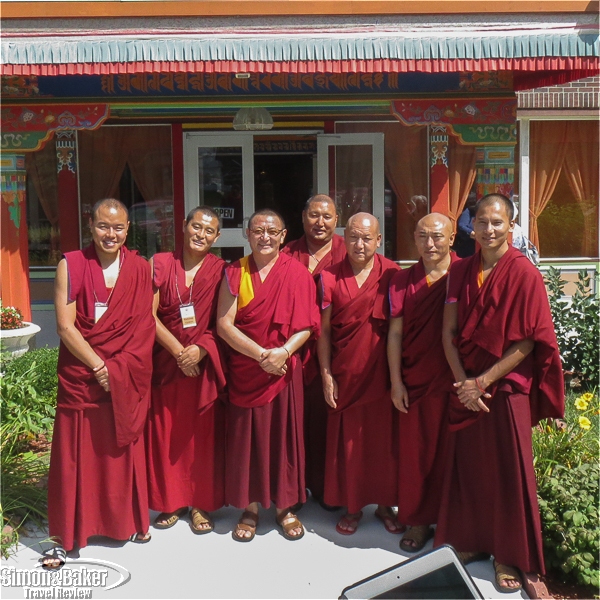
Tibetan monks from the Labrang Tashi Kyil and Tibetan Mongolian Buddhist Cultural Center, a refugee monastery in Dehra Dun, India
Seven Tibetan monks from the Labrang Tashi Kyil and Tibetan Mongolian Buddhist Cultural Center, a refugee monastery in Dehra Dun, India, were visiting the Center. One by one they recited their life stories. Most of them spoke in their native tongue while one of their colleagues translated in thickly accented English. A Center volunteer explained they were touring the United States to share a message of wisdom, and searching donations for their monastery, where 50 young monks from the Tibetan-Himalayan region were awaiting education and receiving healthcare.
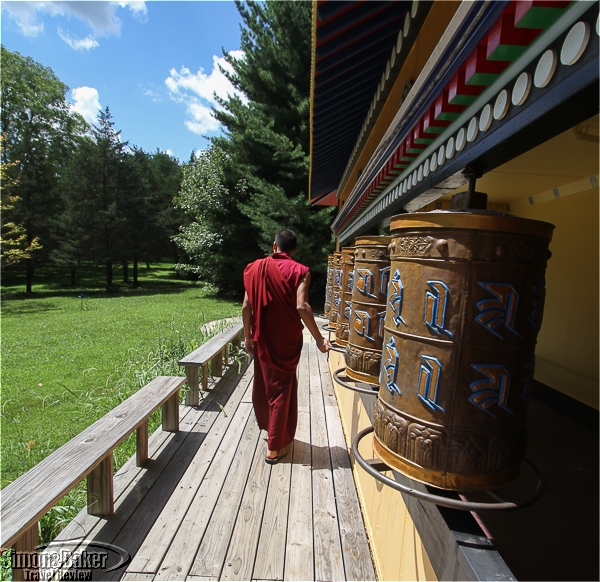
A monk walked by the wheels at the Tibetan Mongolian Buddhist Cultural Center

Tibetan style sand artwork in the Dalai Lama’s private quarters
From there we walked a short distance over a narrow paved path and green grass to the wheels and stupa en route to the Kumbum Chamtse Ling Monastery set aside for classes, meditation instruction and retreats. The upper floor, closed to the public, was home to the private quarters of the Dalai Lama, the religious leader of Tibetans.
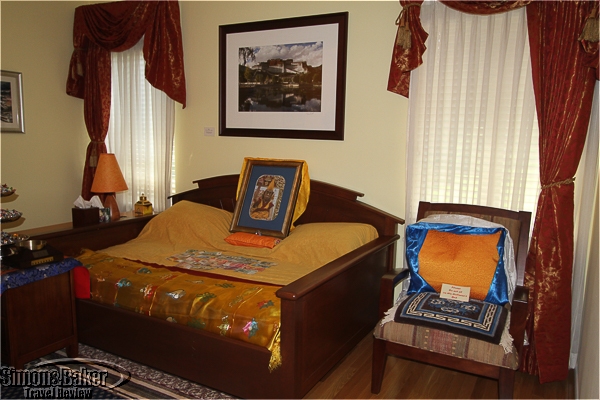
The Dalai Lama’s bedroom
The 501 (C) 3 nonprofit organization’s main sources of funding were programs, facility rentals, donations and guest lodging. I would recommend a stop at the Tibetan Mongolian Buddhist Cultural Center (3655 Snoddy Road, Bloomington, Indiana, 47408, United States, +1 812 336 6807, TMBCC.org, tmbcc.kc@gmail.com) to friends wishing to visit a Tibetan Buddhist temple in the United States. I enjoyed lunch, and the three-hour afternoon group tour, and would welcome the opportunity of a return independent visit with quiet time to further explore the center and its grounds.
Why we treasured private tour at Miami wildlife sanctuary
By Elena del Valle and photos by Gary Cox
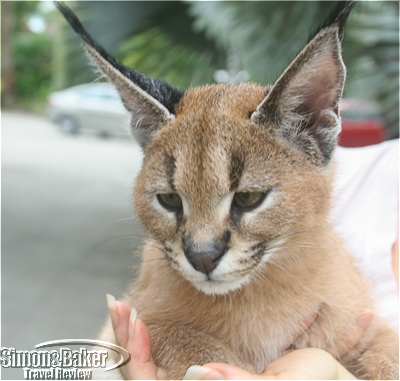
Freya, a caracal lynx
As I stood near a lion themed water fountain in a subtropical garden at the Zoological Wildlife Foundation in the southwestern suburbs of Miami, Florida holding Freya, a relaxed caracal lynx, an African khaki colored wild cat with pointy ears, I marveled and took a mental snap shot of the special moment. Never in the many safari drives and walks I have been fortunate enough to enjoy over the years had I come close to the elusive bush animal. Freya allowed me to pet its head and back. I was surprised at how soft the fur felt and how comfortable Freya was settled in my arms.
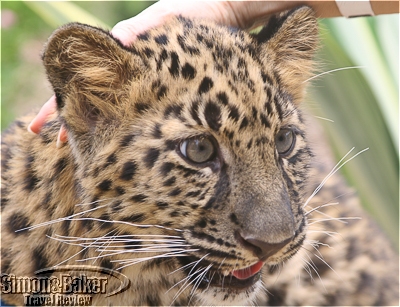
Vadim, a rare amur leopard
Sure, the caracal’s attention span was fleeting. It turned left toward a group of visitors near the monkey cages and right as the sounds of nearby construction drew its attention. Yet it was calm, allowing me to savor the experience while my partner struggled to photograph it because while its body remained immobile its head swiveled around constantly. It was curious and distracted, making it difficult to capture even a single clear image.
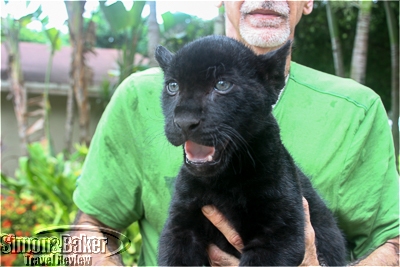
Mario Trabaue holding Onyx, a restless black jaguar
Next, we had a chance to hold Onyx, a young black jaguar. Despite the clouded midday sky we could see the muted rosettes on his black coat. They were stunning. Freya seemed downright angelic in comparison to the gorgeous jaguar who would not be still, not even in the arms of its expert handler. After a few moments of intense and futile wrangling I passed Onyx back to him. He had little more luck than I did. Eventually it was my travel partner’s turn to hold the cat. When for an instant Onyx calmed down I lifted the camera to take photos until my partner yelped. The reason the cat had seemed less agitated was because it was defecating and the excrement landed on his arm. The incident did nothing to dampen our enthusiasm. He cleaned his arm as best as he could with the chilled iced tea bottle we had at hand while we watched Onyx leave in the company of its owners, Maria C. Tabraue and Mario Trabaue, who had come to greet us during our Zoological Wildlife Foundation Private Tour with a primate and feline interaction session.
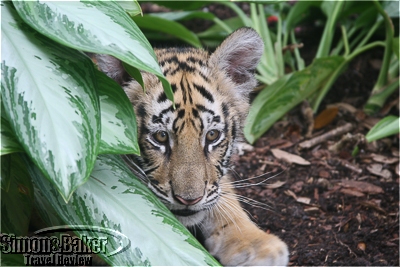
Sarabi, a playful tiger cub
Stephen Gregorio, our friendly guide and the Foundation’s zookeeper, had Vadim, a rare amur leopard, on a leash a few feet away from us. They had been standing there during our interaction with Onyx. Vadim too returned to his enclosure shortly after Onyx. In the interim, we awaited the arrival of Sarabi, an adorable tiger cub. We could not get enough of him. He acted like the aloof celebrity he was, gently biting his handler’s pants, pouncing on plants, and stalking invisible prey. We also spent quality time with Amorette, a capuchin monkey, and after her Chung, a gibbon. Curious and playful she arrived with a stuffed companion and was relatively calm in my arms. Chung, on the other hand, wouldn’t hold still for a moment, and was desperate to flee and explore on his own.
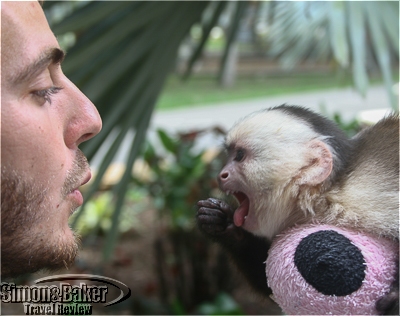
Stephen Gregorio, zookeeper at the Foundation, and Amorette, a capuchin monkey
Many of the non human inhabitants of the Foundation were born there (50 percent of the babies had been born and remained at the facility) or transferred from Zoological Association of America accredited facilities. Some were rescues from people who could no longer house them while others had been seized from owners without permits or wildlife violators. Still others had been abandoned, injured or brought for rehabilitation. Whenever possible the Foundation released rehabilitated animals, a spokesperson explained.
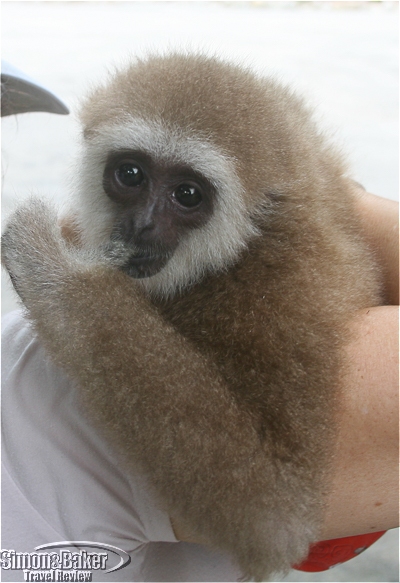
Chung, a gibbon, wanted to explore
The five-acre facility welcomed approximately 20,000 visitors per year. While we awaited our tour guide in the check-in arrival area we heard several foreign languages. It was no surprise since slightly more than half of the visitors were from out of the state or the country. I imagined the intimate wildlife experience drew many of the tourists from near, like us, and far away. According to a 2014 article by Sharon Guynup in NationalGeographic.com only 3,000 tigers may remain in the wild.
According to WildLifeConservationSociety.com only 25 to 40 amur leopards remain in the wild. During our visit to the Foundation we saw a tiger and an amur leopard. They were clean and appeared to be well looked after by the staff. While my preference remains to see wildlife in its natural habitat, in those cases where the animals may no longer survive and thrive in the wild a captive environment may be the only alternative. The Foundation provided a home for its animal residents and an opportunity for visitors to support the upkeep of the animals and at the same time visit them. It was a memorable experience worth repeating.
Greece revisited, adventure road travel through the Pindus Mountains
Article and photos by Josette King

The Gulf of Corinth
I thought I knew Greece. I had visited a couple of its legendary islands and snorkeled in the crystalline waters of its rocky coves. I had stayed in Athens long enough to explore most of its nearby ancient ruins. I had enjoyed the taverna food and the street musicians playing their ornate nine-string bouzouki. And I had learned to stay clear of ouzo, the fiery local brew. So, yes I thought I knew Greece. Until I came across an eight-day Tripology Adventures itinerary from Athens to the Pindus Mountains with overnight stops in Delphi, Ano Chora, Karpenisi, Kalampaka and back to Athens.
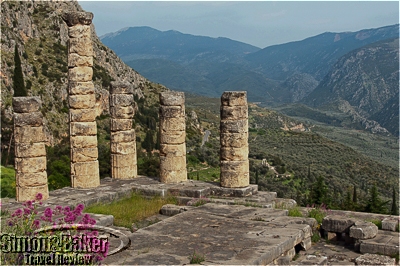
Columns of the temple of Apollo in Delphi
Tripology is an adventure travel company that has been leading self-drive caravans of all-wheel drive vehicles into remote history-rich areas of the planet for over two decades. The Pindus Mountain Range, the vast backbone of peaks, valleys and gorges that traverses the Greek mainland from the northwest to the southeast definitely fit that profile. It is covered with forests so impenetrable that its central region, the Agrafa (Greek for unchartered), succeeded in maintaining its autonomy throughout the four centuries of Ottoman occupation of the country, becoming a refuge for the fiercely independent souls who wanted to escape the oppressors. That wild, sparsely inhabited region has remained relatively pristine to this day. Most of the roads that wind their way up and down its steep slopes are still unpaved. That was a unique opportunity to venture on terrains that I knew better than to attempt on my own and explore a Greece I hadn’t realized still existed.

Statuary from the Delphi Archeological site now on display in its museum
Our five-vehicle convoy left Athens on a sunny spring morning, four late model 4 x 4 vehicles packed with eager adventurers, 14 of us in all, following the lead land cruiser with our guide, Yoav Barashi, a seven year veteran of Tripology tours in the area. Our lead driver Nikos Manolis, an expert all terrains driver, was also a noted figure in the Greek rally community. The highlights of the first day, a relaxed seaside lunch on the Gulf of Corinth and a privately guided tour of the archeological site of Delphi, were a pleasant nod to familiar Greece, and an ideal opportunity for us to get acquainted with our traveling companions and our vehicles.
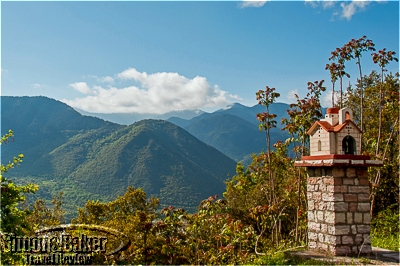
Tiny roadside shrines were a frequent sight
The next morning, the roller-coaster ride that was to become the norm for our entire 1,200 kilometer trip began in earnest as we negotiated Bauxite Way. The 24 kilometer (15 mile) uphill strip of gravel and tight turns is one of the best known stages of the Acropolis Rally of Greece, named after the nearby aluminum ore mine and the prevalent red dust. After the exhilarating driving experience followed by a break at the shaded terrace of a village taverna, we were on our way again. That time we climbed up a rough unpaved trail that hugged the rock face and curved incessantly upon itself on our way to a mountaintop picnic. Our lunch scenery was a jaw-dropping view of densely forested canyons and craggy peaks. Then after an equally tortuous descent we ended up at a rustic village inn for the night.
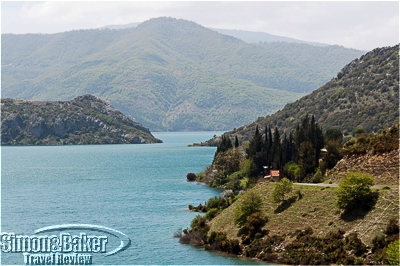
Lake Mornos
Day after day, as we drove deeper into the Pindus and entered the Agrafa area, the mountains became higher, the canyon deeper and the trails hewed out of the rock more forbidding. Those dramatic vistas bursting with the colors of spring were a photographer’s paradise. Each turn revealed a better view of snow capped peaks, a turquoise lake sculpted by canyons in the shape of a giant octopus or a hill dotted with the purple blooms of Judas trees. Tiny roadside shrines were a frequent sight, presumably meant to petition for divine protection on behalf of intrepid travelers or offer thanks for road catastrophes avoided as much as to mark the spot of one that had been.
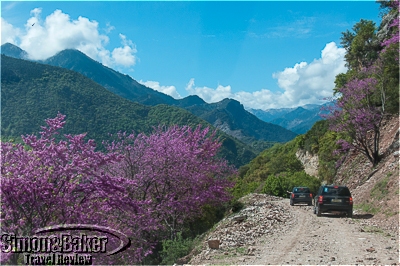
The mountain roads were lined with Judas trees in full bloom
We could drive for hours without seeing a sign of human life, much less another car. Then a shepherd with his flock of long haired sheep appeared, or a herd of goats plundering the high grass at the edge of road or beekeepers tending their hives. One more bend in the road would reveal a village of sturdy stone houses stacked against the mountain, and blending into the rock. We would stop in the central platia, the village square at the heart of every Greek village bookended by the ubiquitous taverna on one side and the village church on the other. Even the smallest of churches was a treasure trove of gilded icons and byzantine style frescoes.
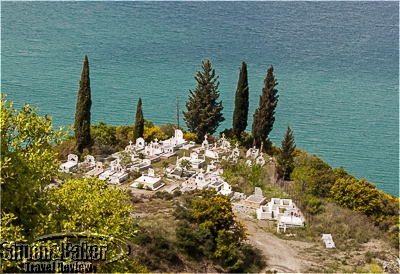
Cemetery on the shore of Lake Kremaston
Our guide Yoav was remarkable for his extensive knowledge of the region and also for his passionate interest in it, which he shared over our two way radio channel. He brought places and events into human context, shedding light on a vibrant and often tragic history that is little more than a footnote in western history books. He was equally knowledgeable of the tales of Greek mythology, mimicking to great effect the foibles of Zeus, Apollo, Hermes and even Aphrodite or Psyche. Had my high school history teacher possessed a fraction of his story telling talent, I might have been an ancient Greece scholar today.
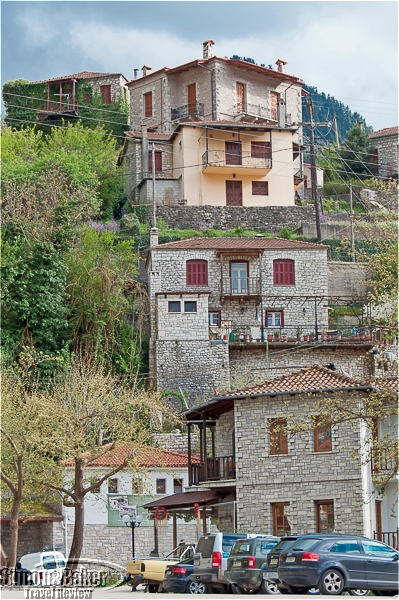
Villages were stacked against the hillsides
Do I know Greece now? I do, a little better at least. But more importantly, thanks to this road journey, I fell in love with the country. I now yearn to return at the first opportunity. And best of all, I so enjoyed the Tripology Adventures way of exploring new horizons that I am already searching their destinations for my next road adventure.
Some of our favorite Paris bakeries and sweets and chocolate shops
By Elena del Valle and photos by Gary Cox
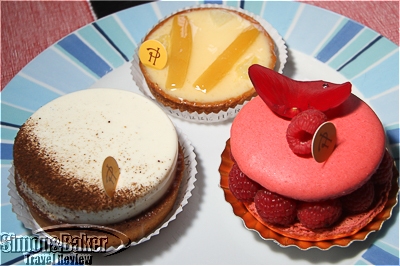
Delicious Pierre Hermes desserts

Caramel salted butter, white truffle, tangerine and rose macarons
For many years we have sampled baked goods and chocolates in various neighborhoods in the City of Lights with mixed results. Our tastings and discoveries have led us to a few favorites we return to whenever we are in Paris, France. For example, we like the Pierre Hermes shop on rue Bonaparte in the Latin Quarter. We have been there many times over the years (see Paris macaron maker remains a favorite). It has been our experience that while the shop is small and often crowded the staff members are friendly and efficient. We find the pain au chocolat, Ispahan croissants, Infiniment Vanille tart and single flavor macarons worth hoofing it there from nearby neighborhoods. Our preferred macaron flavors have been caramel salted butter, white truffle, rose and tangerine. Recently, we also sampled the Ispahan Gaufre, a soft cookie sandwich with a waffle like appearance and rose and raspberry filling sold in a single sealed sleeves. In addition to the taste we liked the Gauffre’s slightly longer shelf life compared to the fresh baked goods which only lasted a few days.
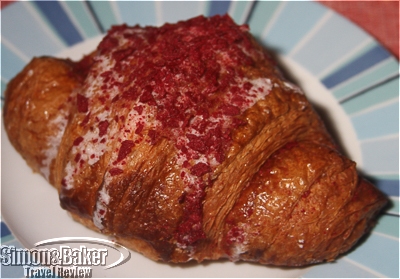
The Isbahan croissant became a new favorite.
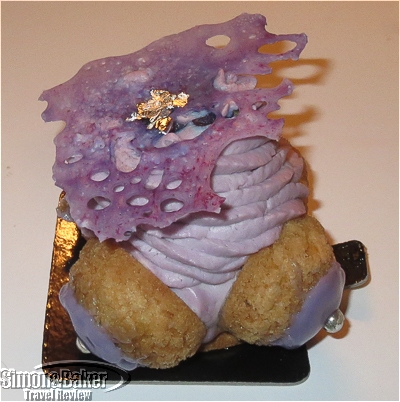
The Lilly Valley from Carl Marletti
In the Left Bank, we liked the vanilla eclairs at La Parisienne bakery on rue Monge. When we were in the mood for our favorite vanilla eclairs we went to Carl Marletti on rue Censier. It was also home of the Lilly Valley, another favorite pastry worth a special trip. It was best to arrive early in the day to avoid leaving empty handed as they sometimes sold out of the Lilly Valley. In the Right Bank, the vanilla eclairs at Stohrer on rue Montorgueil, said to the be oldest bakery in the city, and the mini pain au chocolat were worth a stop.

Vanilla eclairs and mini pain au chocolat from Stohrer

Praline bread from Eric Kayser
We walked to the Eric Kayser bakery on rue Monge for its good cereal baguette and moist mini financier pastries. For small brioches with praline that remind us somewhat in texture and flavor of Hawaiian bread we made our way to the shop on rue des Petits Careaux at the top of rue Montergueil.
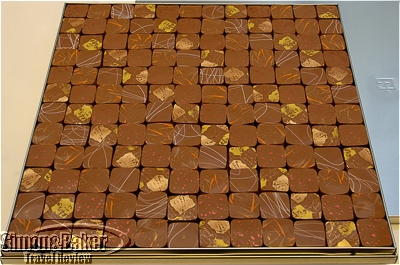
Jacques Genin chocolates
For exceptional candy including artisan marshmallows, marron glaces and candied chestnuts (smaller than the marron glaces) in season, and pate de fruit from the Basque Region we popped into Bon Bon au Palais on rue Monge. If craving delicate chocolate bites we headed to Jacques Genin on rue de Turenne on the Right Bank (see Passionate chocolate, candy maker draw to Paris Marais shop) or the new Left Bank location on rue de Varenne (see Paris chocolate, candy maker opened new Left Bank shop).
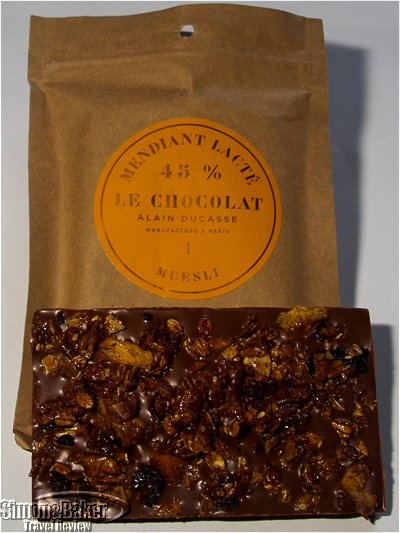
Mendiant chocolate bar from Manufacture
For hearty extraordinary single source chocolate bars we loved the new Alain Ducasse Manufacture shop on rue Saint Benoit in the Left Bank (see Alain Ducasse new Left Bank shop worth a visit for single source dark chocolate). While smaller than the original shop and manufacturing facility on rue de la Roquette on the Right Bank (see The art of making chocolate Alain Ducasse style in Paris) it had the same products on offer. The staff members we met were well informed, service oriented and helpful. In a pinch we would consider the Manufacture stand at the Gallery LaFayette Gourmet store, but only if we happened to be in that area.
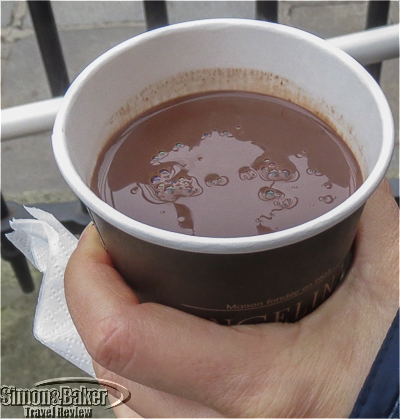
Thick chocolate to go from Angelina
Our favorite way to enjoy hot chocolate was to buy a cup of take out from the Angelina Cafe on rue de Vaugirard on the Left Bank next to the Luxemburg Museum. Served pipping hot it had a dark rich tart flavor that drew us back over and again. The only down side was the take out came without the whipped cream. The rue de Rivoli main shop (and salon) on the Right Bank also sold the hot chocolate to go, but the one time we tried it the hot chocolate was sweeter, milkier and missing the tart finish we liked so much.








